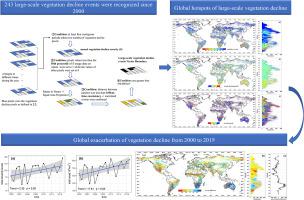Science of the Total Environment ( IF 9.8 ) Pub Date : 2022-05-31 , DOI: 10.1016/j.scitotenv.2022.156411 Ruohua Du 1 , Jianjun Wu 1 , Jianhua Yang 1 , Feng Tian 1 , Meng Chen 1 , Ting Mao 1

|
Extreme climate-induced vegetation greenness decline significantly affects the stability of ecosystem function. Extreme climate events have occurred frequently in the recent 20 years and the possibility of climate anomalies is forecasted to increase in the future. But currently, the spatial and temporal response of episodic local vegetation decline to climate extremes at a global scale are still unclear. In this study, the detrend NDVI data was utilized as the indicator of vegetation growth, and a spatiotemporally contiguous recognition method was proposed to identify episodic large-scale vegetation decline events globally, subsequently, the spatiotemporal characteristics of these vegetation decline events and their interannual variation trends during 2000–2019 were explored. The results showed that (1) the spatiotemporally contiguous recognition method proposed by this paper was proven to be accurate in identifying the hotspot regions of large-scale vegetation decline. A total of 243 large-scale vegetation decline events were recognized globally during 2000–2019 drived by the method. (2) The global hotspots of large-scale vegetation decline were mainly distributed in the low-elevation areas at middle and low latitudes, especially at 15°S ~ 35°S, 15°N and 35°N, where covered north-western Africa, the Sahel, the Middle East, Central Asia, western India, the border of north-eastern China and Mongolia, western and south-central United States, northern Mexico, southern Africa, Australia, and southern and north-eastern South America. (3) Recent global episodic local vegetation decline has increased significantly since 2000, at the rate of 180,000 km2 of vegetation decline areas increasing per year. Particular, the severity of vegetation decline grew significantly since 2010 at the regions where covered the latitudes of approximately 15°N, 30°N and 65°N. Additionally, the severity of vegetation decline ranging from 20°S to 30°S weakened significantly since 2010. These findings were expected to provide the valuable scientific understanding for global vegetation decline and ecosystem responses to frequent climate extremes.


























 京公网安备 11010802027423号
京公网安备 11010802027423号